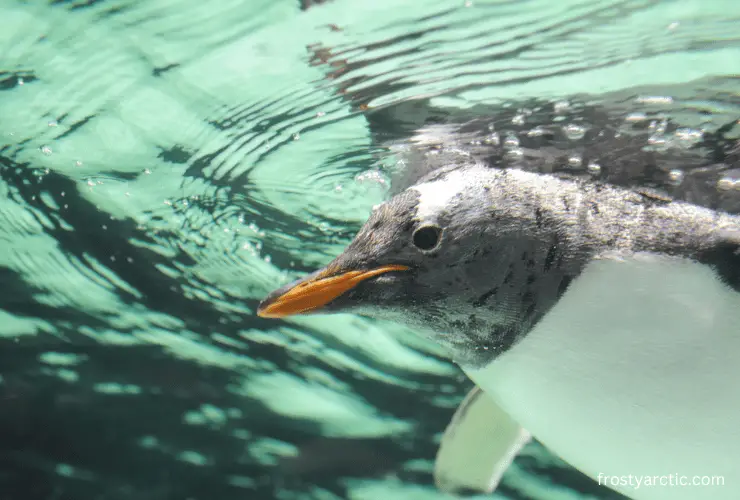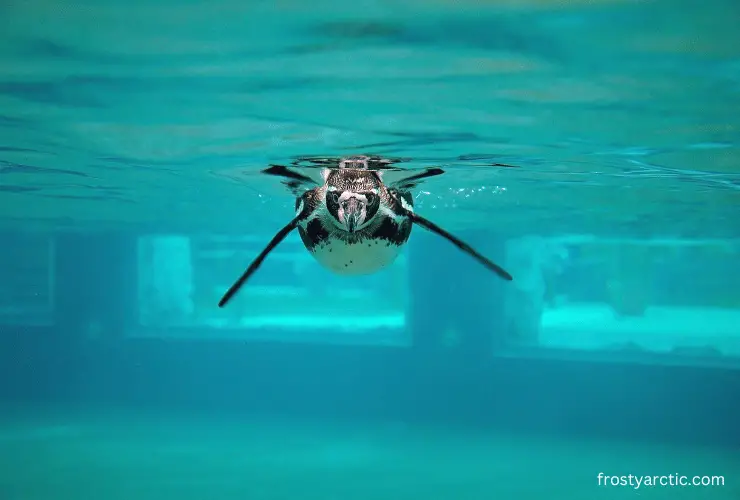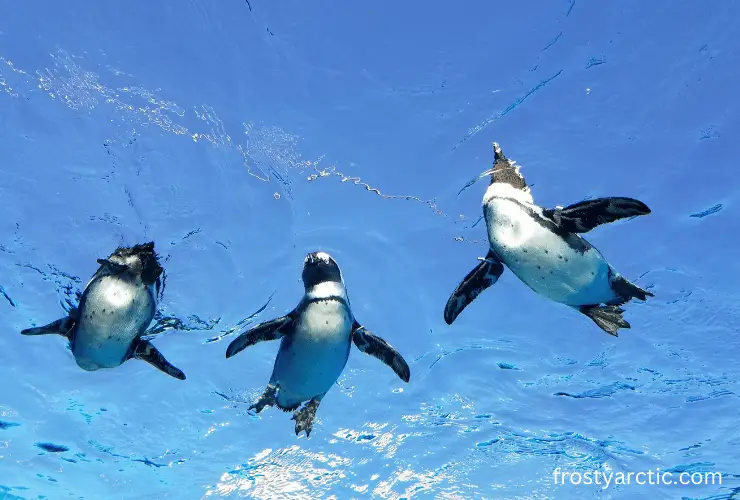Emperor penguins, the largest species of penguin, can dive to depths of over 550 meters (1800 feet). Adelie and King’s penguins can dive to depths of around 300 meters (980 feet), while Gentoo and chinstrap penguins dive to depths of approximately 60 to 120 meters (200 to 400 feet).
Penguins are excellent swimmers and divers, capable of diving to great depths in search of food.
However, diving depths can vary depending on the species and the individual, as well as environmental factors such as water temperature and visibility.
Let’s learn more about the diving behavior of penguins and their life in the ocean!
Are Penguins Good Divers? Why Do They Dive So Deep?
Yes, penguins are excellent divers and are known for their ability to swim and dive deep into the ocean in search of food.
They have several adaptations that make them well-suited for diving, including waterproof feathers, dense bones, and specialized muscles.
The reason why penguins dive so deep is to find food. Penguins mainly feed on fish and squid, which are often found at deeper depths in the ocean.
Diving into these depths allows penguins to access a rich food source, which is essential for their survival. By diving so deep, penguins can sustain their populations and thrive in their harsh polar environments.
How Deep Can Penguins Dive? How Long Can Penguins Stay Underwater?
Different species have varying diving capabilities, with emperor penguins capable of diving the deepest among penguins, sometimes reaching over 550 meters (1800 feet).
Penguins have several adaptations, such as dense bones and specialized muscles, that allow them to stay underwater for extended periods from several minutes to over 20 minutes.
This underwater hunting is crucial to their survival and the ability to thrive in harsh environments.
How Deep Can King Penguins Dive?
King penguins are capable divers and can dive to depths of around 300 meters (980 feet) in search of food.
These penguins mainly feed on small fish and squid, which they find at deeper depths in the ocean. Their ability to dive to these depths allows them to access a rich food source, which is essential for their survival. ~ National Geographic
How Deep Can Little Penguins Dive?
Little penguins, also known as fairy penguins, are the smallest species of penguin and can dive to depths of around 20 meters (65 feet).

They feed mainly on small fish and squid, hunting close to the surface or in shallow waters.
Unlike their larger relatives, little penguins do not dive as deep, but they make up for it with their agility and speed in the water.
How Deep Can Humboldt Penguins Dive?
Humboldt penguins are capable divers and can dive to depths of around 60 to 120 meters (200 to 400 feet) in search of food.
They feed mainly on small fish and squid, which they hunt in the deeper waters of the ocean. ~ National Geographic
How Deep Can African Penguins Dive?
African Penguins, also known as Jackass Penguins, are known to dive up to depths of 60-80 feet (18-24 meters) in search of food.
These birds are unique to the southwestern coast of Africa and feed primarily on small fish and squid.
African Penguins are endangered, with populations declining due to habitat loss, overfishing, and oil spills. Conservation efforts are underway to protect these fascinating birds and ensure their survival.
How Do Penguins Survive Deep Dives? Penguin Adaptations for Diving
Penguins are well adapted to survive the challenges of deep diving, including pressure changes, darkness, and cold water.
They have several physical adaptations, such as waterproof feathers that insulate their bodies and reduce drag. Other adaptations that help them survive underwater include:
- Heavy bones: help them sink to the bottom of the ocean and dive to great depths.
- Paddle-like flippers: penguin uses their flappers to swim in the water at speeds of 20 km per hour.
- Wedge-shaped tail: helps climb across rocks and up steep cliffs from the shore.
- Webbed feet: help them steer themselves and propel their bodies while swimming.
- Feathers: penguin feathers are waterproof, with a layer of short, stiff, hooked penguins that insulate them in the water. Their feathers are also oily, which keeps them clean and dry even in the water.
- Salt glands: they are located between the eyes and remove salt from seawater and fish.
These adaptations, combined with their ability to regulate their heart rate and blood flow, enable penguins to successfully dive to depths of over 500 meters (1600 feet) in search of food.
How Fast Can Penguins Dive?
The speed at which penguins dive varies depending on several factors, such as the species of penguin and the depth of the dive.

On average, penguins can dive at speeds of around 15 to 20 km/hr (9 to 12 mph). However, they can reach much higher speeds when they need to escape from predators or pursue fast-moving prey quickly.
The streamlined bodies and flippers of penguins allow them to swim and dive quickly and efficiently, making diving and underwater hunting a critical aspect of their survival in the ocean.
Despite the speed at which they can dive, penguins can also control their movements and swim precisely, allowing them to navigate their underwater environments easily.
How Do Penguins Dive?
Penguins dive by jumping into the water from the surface and then swimming down to depth.
As they swim, they use their flippers to provide propulsion and steer their movements, while their tails help to control their direction and balance.
Penguins can control their buoyancy by adjusting the amount of air in their air sacs, which allows them to sink or rise as needed. This, combined with their dense bones, helps them to maintain neutral buoyancy and swim effortlessly through the water.
Once they reach the desired depth, they then use their specialized muscles to hunt for food, such as small fish and squid.
When they are ready to return to the surface, penguins simply swim back up, breaking the surface with their heads.
Why Don’t the Penguins Get the Bends?
The bends, also known as decompression sickness, occur when dissolved nitrogen in the blood forms bubbles due to rapid changes in pressure, often during a rapid ascent from a dive.
Penguins, however, can avoid the bends by slowly adjusting their body to the changing pressure as they return to the surface. They have a specialized mechanism in their bodies that allows them to adjust the amount of nitrogen in their bloodstream, minimizing the formation of harmful nitrogen bubbles.

Additionally, penguins’ high metabolism and efficient oxygen storage systems enable them to remain underwater for extended periods, allowing them to adjust gradually to the changing pressure as they ascend to the surface.
By avoiding the bends, penguins can continue diving safely and effectively, which is critical for their survival in the ocean. ~ Oceana
FAQs:
What is the deepest diving penguin?
The deepest diving penguin is the Emperor Penguin. They have been known to dive to depths of over 565 feet (172 meters) in search of food. This has made it one of the most successful hunters in the harsh Antarctic Ocean environment.
Can emperor penguins dive deeper than whales?
Yes, Emperor Penguins have been known to dive deeper than some species of whales. Emperor Penguins have been recorded diving to depths of over 565 feet (172 meters), which is deeper than the average dive depth for many species of whales.
Can you scuba dive with penguins?
Scuba diving with penguins is possible, but it depends on the location and the species of penguin. Some popular destinations include the Galapagos Islands and South Africa, where it is possible to swim with African penguins.
How fast do penguins dive?
Penguins can dive at speeds of up to 15 miles (24 kilometers) per hour. This impressive speed allows them to quickly and efficiently catch fish and other prey in the ocean.
Conclusion
In conclusion, penguins are remarkable creatures that are adapted for life in the ocean. They are excellent divers, capable of diving to great depths and speeds in search of food.
Some species, such as the Emperor Penguin, are capable of diving deeper than some whales. Penguins are also able to avoid the bends by having a slower ascent rate and the ability to control their breathing.
While it is possible to scuba dive with penguins in some locations, it is important to follow ethical and responsible diving practices to ensure that the penguins and their habitats are not disturbed.
Overall, penguins are fascinating and awe-inspiring creatures that are perfectly adapted for life in the ocean.



4 thoughts on “How Deep Can Penguins Dive? [Explained]”